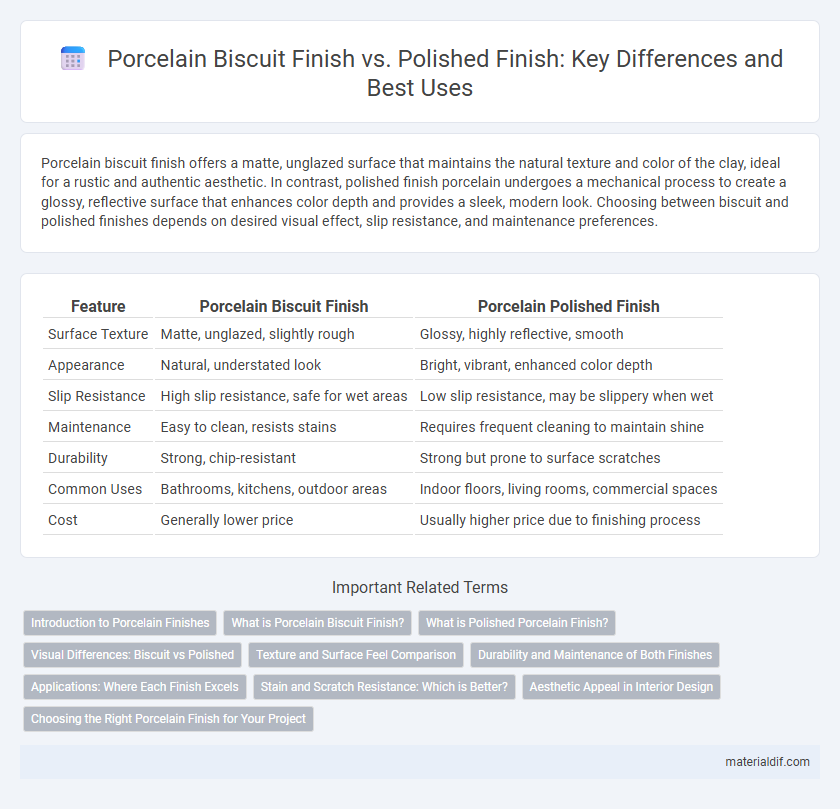Porcelain biscuit finish offers a matte, unglazed surface that maintains the natural texture and color of the clay, ideal for a rustic and authentic aesthetic. In contrast, polished finish porcelain undergoes a mechanical process to create a glossy, reflective surface that enhances color depth and provides a sleek, modern look. Choosing between biscuit and polished finishes depends on desired visual effect, slip resistance, and maintenance preferences.
Table of Comparison
| Feature | Porcelain Biscuit Finish | Porcelain Polished Finish |
|---|---|---|
| Surface Texture | Matte, unglazed, slightly rough | Glossy, highly reflective, smooth |
| Appearance | Natural, understated look | Bright, vibrant, enhanced color depth |
| Slip Resistance | High slip resistance, safe for wet areas | Low slip resistance, may be slippery when wet |
| Maintenance | Easy to clean, resists stains | Requires frequent cleaning to maintain shine |
| Durability | Strong, chip-resistant | Strong but prone to surface scratches |
| Common Uses | Bathrooms, kitchens, outdoor areas | Indoor floors, living rooms, commercial spaces |
| Cost | Generally lower price | Usually higher price due to finishing process |
Introduction to Porcelain Finishes
Porcelain finishes vary primarily between biscuit and polished options, each offering distinct textures and aesthetics. Biscuit finish features a matte, unglazed surface that provides a natural, slip-resistant feel ideal for high-traffic areas. Polished finish, on the other hand, delivers a glossy, reflective surface that enhances color depth but requires more maintenance to prevent scratching and staining.
What is Porcelain Biscuit Finish?
Porcelain biscuit finish refers to the natural, unglazed surface of porcelain tiles or dinnerware, retaining the original matte texture and pale, off-white color of the fired ceramic body. This finish showcases the raw, unpolished quality of porcelain, offering a subtle, understated aesthetic with enhanced slip resistance compared to polished surfaces. It is favored in applications requiring a more natural look and tactile feel, along with durability and minimal maintenance.
What is Polished Porcelain Finish?
Polished porcelain finish is a highly refined surface treatment achieved by mechanically grinding and buffing porcelain tiles to a mirror-like sheen, enhancing their natural colors and patterns. This finish offers a sleek, glossy appearance that intensifies the tile's aesthetic appeal while providing a smooth, reflective surface ideal for modern interiors. Polished porcelain is less porous than unpolished options, making it more resistant to stains but also potentially more slippery when wet.
Visual Differences: Biscuit vs Polished
Porcelain biscuit finish exhibits a matte, unglazed surface with a natural, slightly rough texture that emphasizes the raw clay's creamy color and subtle tonal variations. In contrast, the polished finish offers a glossy, reflective surface that enhances color depth and creates a sleek, smooth appearance with sharper detail definition. These visual differences significantly influence the ambiance, with biscuit finish providing a rustic, organic look and polished finish delivering a modern, sophisticated aesthetic.
Texture and Surface Feel Comparison
Porcelain biscuit finish features a matte, unglazed surface that offers a slightly rough texture ideal for slip resistance and natural aesthetic appeal. In contrast, polished porcelain finish is smooth and glossy, achieved through mechanical grinding and polishing, resulting in a sleek surface that enhances light reflection and visual depth. The tactile experience varies as biscuit finish feels more textured and earthy, whereas polished finish provides a slick, cool-to-touch sensation perfect for modern, high-traffic areas.
Durability and Maintenance of Both Finishes
Porcelain biscuit finish offers superior durability with minimal surface treatment, making it highly resistant to scratches and stains while requiring low maintenance. Polished porcelain finish, though aesthetically striking with its glossy surface, demands careful upkeep to prevent etching and visible wear from heavy foot traffic. Both finishes provide strong structural integrity, but biscuit finish is preferable for high-traffic areas due to its enhanced resistance and ease of cleaning.
Applications: Where Each Finish Excels
Porcelain biscuit finish exhibits a matte, unglazed surface ideal for high-traffic commercial spaces and outdoor applications, offering exceptional slip resistance and durability. Polished porcelain finish showcases a glossy, reflective surface suited for upscale residential interiors, luxury retail stores, and hospitality environments where elegance and easy cleaning are paramount. Both finishes deliver strong resistance to stains and wear, but the biscuit finish excels in functional environments, while the polished finish enhances aesthetic appeal.
Stain and Scratch Resistance: Which is Better?
Porcelain biscuit finish offers superior stain resistance due to its unglazed surface, which absorbs fewer liquids and resists discoloration more effectively than polished finishes. Polished porcelain, while visually appealing with its glossy sheen, tends to be more prone to scratching because of the softer surface created during polishing. For environments with high traffic or exposure to staining agents, the biscuit finish provides enhanced durability and easier maintenance compared to the polished finish.
Aesthetic Appeal in Interior Design
Porcelain biscuit finish offers a matte, natural texture that enhances rustic and minimalist interior design themes with subtle sophistication. Polished porcelain finish delivers a high-gloss, reflective surface, amplifying light and creating a sleek, modern aesthetic ideal for contemporary spaces. Both finishes influence spatial perception, with biscuit imparting warmth and understated elegance, while polished provides a bold, luxurious visual impact.
Choosing the Right Porcelain Finish for Your Project
Porcelain biscuit finish offers a matte, unglazed surface that enhances slip resistance and hides scratches, making it ideal for high-traffic or outdoor areas. Polished finish provides a glossy, reflective surface that highlights color and pattern vibrancy but requires more maintenance due to its susceptibility to stains and scratches. Selecting the right porcelain finish depends on project requirements such as durability, aesthetic preferences, and maintenance considerations.
Porcelain Biscuit Finish vs Polished Finish Infographic

 materialdif.com
materialdif.com